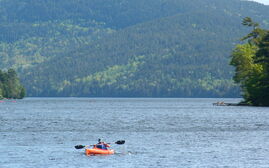UMaine report analyzes coastal climate challenges ahead
Mainers can expect significant environmental changes in the next two decades due to increased greenhouse gas emissions and patterns of climate variability, says a new report by two University of Maine researchers.
The 26-page report, by Sean Birkel and Paul Mayewski, looks at a variety of scenarios for helping coastal Mainers prepare for short- and long-term climate challenges.
Birkel is a research assistant professor and the Maine State Climatologist based at the Climate Change Institute (CCI) and Mayewski is a Distinguished Maine Professor and director of the CCI.
Looking at historical climate trends, climate–commodity connections and sources of climate variability affecting Maine, they came up with five plausible scenarios for 2020–2040.
The scenarios that were analyzed: No additional change to the current “new normal”; moderate warming; another abrupt Arctic warming and even greater Arctic sea ice collapse; cooling from increased volcanic activity; drying from more frequent and extreme El Nino events.
“Global climate models are well suited for simulating long-term trends under different greenhouse-gas emission pathways, but they do not necessarily resolve regional variability enough to make actionable projections only a few years out,” says Birkel.
The coastal region already is experiencing more intense rain events, a longer growing season and increasing temperature extremes, say the researchers.
Three of the state’s coastal commercial crops — blueberry, apple and cranberry — can be positively and negatively affected by a changing climate, depending on the scenarios and changing conditions.
The average growing season since 2000, for example, has increased by about two weeks in comparison to the 20th century mean. August and September temperatures also have warmed two to three degrees Fahrenheit, according to the researchers.
While a longer growing season is beneficial to most crops, there are negative impacts of the changing weather, say Birkel and Mayewski. These include northward migration of pests, extreme rainfall events and more frequent “blocking” patterns in the atmosphere that increase the likelihood of heat waves and drought.
And in the Gulf of Maine, where the sea surface temperature has warmed about three degrees Fahrenheit since 1895, circumstances have changed dramatically for lobster and cod.
Other studies have indicated the cod fishery collapsed primarily due to overfishing. But ensuing recovery efforts have not rebuilt the population, as waters in the Gulf of Maine have warmed above the temperature range which cod can tolerate.
Lobster abundance has increased fourfold since the late 1980s largely in connection to warming waters, but a study released in January, which was led by scientists at the Gulf of Maine Research Institute and colleagues at the University of Maine and the National Oceanic and Atmospheric Administration, suggested that lobsters' productivity will decrease as temperatures continue to warm.
Birkel and Mayewski found that increased temperatures in the Gulf of Maine correlate with stronger surface winds in the summer that drive more warm water from the Gulf Stream into the Gulf of Maine.
Changes in atmospheric patterns spanning the Arctic and North Atlantic also are associated with an increase in summer precipitation, especially from 2005 to 2014.
Annual blueberry yield, though strongly impacted by mechanization and other factors, correlates with changes in this large-scale circulation, the researchers found.
DOWNLOAD PDFs














Comments